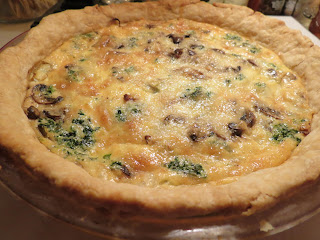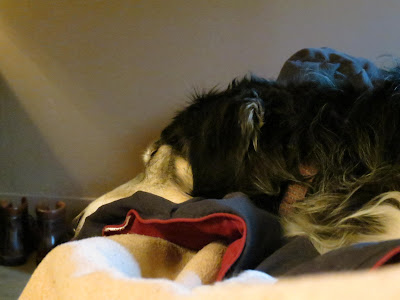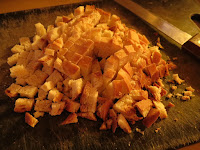Christmas Eve supper for me
is macaroni and cheese. I can put it together fairly quickly and, once it’s
gone into the oven, turn my attention to preparing for the next day. My only
suggestion for mac and cheese, since everyone has his or her own way of making
it, is to use a flat-bottomed whisk like the one above to stir the Béchamel
sauce for the perfect velvety texture.
The more familiar wire whisk
also had a job to do on Thursday evening, as I’d decided to make a quiche for
our now-traditional Christmas Day breakfast in bed. Since David likes cold,
day-after quiche better than fresh-out-of-the-oven quiche, that meant I could
make it the night before. Havarti cheese, plenty of soft, sauteed onions,
chopped spinach, mushrooms, and then (the whisk’s job) beaten eggs, milk, heavy
cream, and Swiss cheese. I’ve had more photogenic crusts than this one – it was
a little skimpy on the edges – but except for its look, it was a complete
success.
Yes, heavy cream in the
quiche! Shocking, I know. But I could hardly wait for the next morning and a
special, not merely a café au lait
but un café crème, the most
luxurious beginning possible to a festive day. We live in a simple old
farmhouse, and my kitchen is tiny, but bottles of Shetler’s milk and cream in
the refrigerator make me feel rich!
For several years we have not
traveled on holidays. I feel a need to be in my bookstore as much as possible
when other people’s relatives are coming home to Northport, and then (though it
would have been no problem this
year) there is the unpredictable nature of weather in November and December.
Short driving days, dark coming on early, crowded highways, possibilities of
ice and snow, added to the possibility of book-buying customers -- all this
conspires to keep us at home. It makes for a quiet Christmas, but we’ve
adjusted to it.
Not long ago I had to have
presents under a tree in the living room and, like an impatient child, would
wake early and fret until I could get David out of bed, into his robe, and out
to the living room to open presents. Finally I faced reality: I was a child no
longer, and he had no desire to leave the coziness of bed for the chill of
another room. Opening presents by a tree didn’t mean much, if anything, to him.
So I capitulated. Now we have breakfast and presents in bed, where we are as
cozy as cozy can be, and where this year our new windows and freshly painted
bedroom walls added to the morning’s splendor.
The pack had a luscious day
of lying around. I had a good book to read in bed (The Book of Lights, by Chaim Potok), NPR gave us soft instrumental and
chorale music for a while before changing over to stories, and Sarah, having
gone for a big walk with me up the hill before breakfast, was content simply to
be with us.
Lamplight on the walls was
lovely, as were random patterns of willow branches outside the window.
Later we went for a long,
slow ride in the car, finishing up with a walk for me and run for Sarah. I
threw sticks, and she chased after them. The temperature was dropping, though,
and the sun lowering to the horizon, and we were all content to be going back
home again, where oranges and pistachios graced the table and kept human
appetites in check during the remaining time before dinner.
When I had asked David what
he wanted for Christmas dinner, he said not to go to any trouble, which was
fine, but I still wanted to do something out of our ordinary run of meals. My
solution met both requirements. David loves pork ribs (which we almost never
have at home) and doesn’t like anything at all done to them – no marinade, no
sauce, no nothing. Just very well-done, crispy ribs, slow-roasted in the oven,
and nothing could be easier than that, I figured. He requested double-baked
potatoes, another rarity in our house, and that was fine, too.
I forgot to photograph my
holiday vegetable dish once it was put together, and that’s a shame, because it
could not have been prettier: broccoli, red pepper, walnuts, vinaigrette tossed
together. The pepper can be sauteed in olive oil at the start of meal
preparation, but the broccoli should be steamed only just before it’s all tossed together and brought to the
table, to keep the vegetable bright green. The colors should sing!
Two kinds of cranberry sauce,
the tart with orange for David, the sweet cooked kind for me. Simple,
traditional.
Dessert was simple, too. (I
confess we had already had homemade shortbread and spice cookies for dessert
with our breakfast. Thank you, friend Sally!) You can see we are a Shetler’s
household, but finding their eggnog custard ice cream at NJ’s was a delightful
surprise. Square of Lindt dark chocolate tucked into each small dish.
So, only two meals for us on
Christmas, and we refrained from having seconds. We got outdoors for scenery
and exercise and fresh air. We lazed around like pashas. It was a lovely,
lovely day. We felt deep gratitude. Even without snow.


























































